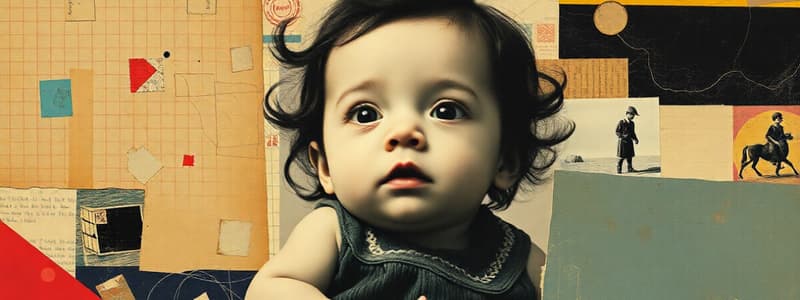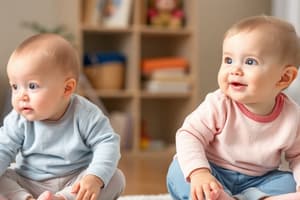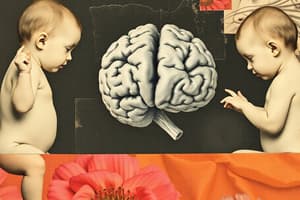Podcast
Questions and Answers
What is the primary focus of Freud's psychosexual stages during infancy?
What is the primary focus of Freud's psychosexual stages during infancy?
- Development of self-concept
- Satisfaction from oral activities (correct)
- Building trust and security
- Need for social interaction
Which stage of Erikson's theory focuses on trust versus mistrust?
Which stage of Erikson's theory focuses on trust versus mistrust?
- Stage 4: Industry vs. Inferiority
- Stage 5: Identity vs. Role Confusion
- Stage 1: Trust vs. Mistrust (correct)
- Stage 3: Initiative vs. Guilt
What does synchrony in parent-infant interactions promote?
What does synchrony in parent-infant interactions promote?
- Detachment in relationships
- Higher intelligence scores in infants (correct)
- Increased emotional distress in infants
- Reduced cognitive development
Which statement about the mother-infant bond is true?
Which statement about the mother-infant bond is true?
Which of the following best describes the concept of fixation in Freud's theory?
Which of the following best describes the concept of fixation in Freud's theory?
What key factor contributes to the positive outcomes noted in highly synchronous 6 to 8-month-old infants?
What key factor contributes to the positive outcomes noted in highly synchronous 6 to 8-month-old infants?
What characteristic distinguishes the mother's role in caregiver routines compared to the father's?
What characteristic distinguishes the mother's role in caregiver routines compared to the father's?
Erikson's first stage of psychosocial development mainly emphasizes which aspect?
Erikson's first stage of psychosocial development mainly emphasizes which aspect?
At what age do babies typically start to learn to identify changes in emotional expressions?
At what age do babies typically start to learn to identify changes in emotional expressions?
Which of the following best describes the final stage of emotional development mentioned for infants?
Which of the following best describes the final stage of emotional development mentioned for infants?
What age do children typically show self-recognition in a mirror according to the Rouge Test?
What age do children typically show self-recognition in a mirror according to the Rouge Test?
What emotional skill is developed by 7 months of age?
What emotional skill is developed by 7 months of age?
What is the primary focus of Dr. Edward Tronick’s still face experiment?
What is the primary focus of Dr. Edward Tronick’s still face experiment?
What is a potential effect of marital conflicts on infants?
What is a potential effect of marital conflicts on infants?
How does higher education of caregivers affect attachment?
How does higher education of caregivers affect attachment?
What impact does a mother's mental health have on her child's attachment?
What impact does a mother's mental health have on her child's attachment?
What characterizes securely attached infants in contrast to insecurely attached infants?
What characterizes securely attached infants in contrast to insecurely attached infants?
What is a consequence of insecure attachment in adulthood?
What is a consequence of insecure attachment in adulthood?
Which factor does NOT influence secure attachment in infants?
Which factor does NOT influence secure attachment in infants?
What long-term effect does secure attachment have on social relationships?
What long-term effect does secure attachment have on social relationships?
Which behavior is associated with mothers who have panic disorder regarding their infants' attachment?
Which behavior is associated with mothers who have panic disorder regarding their infants' attachment?
What hormone is released by mothers during interactions with their infants, which is linked to empathy?
What hormone is released by mothers during interactions with their infants, which is linked to empathy?
What is the primary focus of a father's bond with their infant?
What is the primary focus of a father's bond with their infant?
During which phase of attachment do infants begin to signal primarily to caregivers they spend the most time with?
During which phase of attachment do infants begin to signal primarily to caregivers they spend the most time with?
What behavior is indicative of secure base behavior in infants?
What behavior is indicative of secure base behavior in infants?
What phase involves infants developing an internal model of how their behavior affects their relationship with caregivers?
What phase involves infants developing an internal model of how their behavior affects their relationship with caregivers?
What is a common expression of separation anxiety in infants?
What is a common expression of separation anxiety in infants?
At what age does separation anxiety typically begin to decline in infants?
At what age does separation anxiety typically begin to decline in infants?
Which hormonal response in fathers is associated with physical activity and possibly aggression?
Which hormonal response in fathers is associated with physical activity and possibly aggression?
What characteristic is associated with securely attached mothers?
What characteristic is associated with securely attached mothers?
Which of the following is NOT a dimension identified by Buss and Plomin regarding temperament?
Which of the following is NOT a dimension identified by Buss and Plomin regarding temperament?
What effect do neurological processes have on temperament according to the content?
What effect do neurological processes have on temperament according to the content?
Which term refers to the tendency to select environments that complement one's own characteristics?
Which term refers to the tendency to select environments that complement one's own characteristics?
Which aspect of self-concept emerges between 8 to 12 months of age?
Which aspect of self-concept emerges between 8 to 12 months of age?
What did the classical longitudinal study by Kagan and colleagues reveal about children classified as highly inhibited at 4 months old?
What did the classical longitudinal study by Kagan and colleagues reveal about children classified as highly inhibited at 4 months old?
Which of the following is a primary feature of the Objective Self in toddler development?
Which of the following is a primary feature of the Objective Self in toddler development?
Which of the following statements about insecurely attached mothers is correct?
Which of the following statements about insecurely attached mothers is correct?
What is social referencing primarily used for in infants?
What is social referencing primarily used for in infants?
Which attachment style is characterized by infants showing confused and contradictory behaviors during reunion with the caregiver?
Which attachment style is characterized by infants showing confused and contradictory behaviors during reunion with the caregiver?
During Mary Ainsworth’s Strange Situation, how do securely attached infants typically behave?
During Mary Ainsworth’s Strange Situation, how do securely attached infants typically behave?
What key factor influences the stability of attachment quality in children?
What key factor influences the stability of attachment quality in children?
Which caregiver characteristic is crucial for fostering secure attachment?
Which caregiver characteristic is crucial for fostering secure attachment?
Which attachment style involves infants that avoid or are slow to greet their parent during reunion?
Which attachment style involves infants that avoid or are slow to greet their parent during reunion?
What is a significant factor that can lead to a caregiver being emotionally unavailable?
What is a significant factor that can lead to a caregiver being emotionally unavailable?
What does the protocol of the Strange Situation assess in infants?
What does the protocol of the Strange Situation assess in infants?
Flashcards
Freud's Psychosexual Stages
Freud's Psychosexual Stages
Freud's theory of child development that focuses on the psychosexual development of a child through different stages, each characterized by a specific erogenous zone and conflict.
Oral Stage
Oral Stage
The first stage in Freud's Psychosexual theory where infants derive pleasure and satisfaction primarily through the mouth, such as sucking, chewing, and biting.
Oral Fixation
Oral Fixation
A state where an individual becomes fixated on oral behaviors due to unresolved conflicts during the oral stage. This can manifest as overeating, smoking, or excessive talking.
Mother-Child Symbiotic Relationship
Mother-Child Symbiotic Relationship
Signup and view all the flashcards
Erikson's Psychosocial Stages
Erikson's Psychosocial Stages
Signup and view all the flashcards
Trust vs. Mistrust
Trust vs. Mistrust
Signup and view all the flashcards
Attachment
Attachment
Signup and view all the flashcards
Synchrony
Synchrony
Signup and view all the flashcards
Oxytocin
Oxytocin
Signup and view all the flashcards
Vasopressin
Vasopressin
Signup and view all the flashcards
Bowlby's 4 Phases of Attachment
Bowlby's 4 Phases of Attachment
Signup and view all the flashcards
Secure Base Behavior
Secure Base Behavior
Signup and view all the flashcards
Internal Model
Internal Model
Signup and view all the flashcards
Stranger Anxiety
Stranger Anxiety
Signup and view all the flashcards
Separation Anxiety
Separation Anxiety
Signup and view all the flashcards
Secure Attachment
Secure Attachment
Signup and view all the flashcards
Social Referencing
Social Referencing
Signup and view all the flashcards
Insecure Attachment
Insecure Attachment
Signup and view all the flashcards
Personality
Personality
Signup and view all the flashcards
Insecure-Avoidant Attachment
Insecure-Avoidant Attachment
Signup and view all the flashcards
Temperament
Temperament
Signup and view all the flashcards
Insecure-Ambivalent Attachment
Insecure-Ambivalent Attachment
Signup and view all the flashcards
Heredity's Role in Temperament
Heredity's Role in Temperament
Signup and view all the flashcards
Insecure-Disorganized Attachment
Insecure-Disorganized Attachment
Signup and view all the flashcards
Long-Term Stability of Temperament
Long-Term Stability of Temperament
Signup and view all the flashcards
Niche-Picking
Niche-Picking
Signup and view all the flashcards
Attachment Stability
Attachment Stability
Signup and view all the flashcards
Emotional Availability
Emotional Availability
Signup and view all the flashcards
Goodness of Fit
Goodness of Fit
Signup and view all the flashcards
Contingent Responsiveness
Contingent Responsiveness
Signup and view all the flashcards
Marital Conflict & Attachment
Marital Conflict & Attachment
Signup and view all the flashcards
Education & Attachment
Education & Attachment
Signup and view all the flashcards
Caregiver Age & Attachment
Caregiver Age & Attachment
Signup and view all the flashcards
Maternal Depression & Attachment
Maternal Depression & Attachment
Signup and view all the flashcards
Maternal Panic & Attachment
Maternal Panic & Attachment
Signup and view all the flashcards
Secure Attachment & Later Development
Secure Attachment & Later Development
Signup and view all the flashcards
Insecure Attachment & Later Relationships
Insecure Attachment & Later Relationships
Signup and view all the flashcards
Attachment & Parenting
Attachment & Parenting
Signup and view all the flashcards
Self-concept
Self-concept
Signup and view all the flashcards
Rouge Test
Rouge Test
Signup and view all the flashcards
Emotional Self
Emotional Self
Signup and view all the flashcards
Still Face Experiment
Still Face Experiment
Signup and view all the flashcards
Interpreting Emotional Perceptions
Interpreting Emotional Perceptions
Signup and view all the flashcards
Study Notes
HPCS4027 Introduction to Developmental Psychology
- Course offered at Stanley Ho Community College
- Lecturer: Irene Tsang ([email protected])
- Academic year: 2024-2025, Semester 1
Lecture 3: Social and Personality Development in Infancy
- Course outline: Attachment, Personality, Temperament, Self-Concept
Theories of Social and Personality Development: Psychoanalytic Perspectives (Freud and Erikson)
- Freud's Psychosexual Stages: pleasure-seeking, related to infant's need satisfaction
- Oral stage: derive satisfaction from the mouth
- Mother-child symbiotic relationship: crucial for meeting needs
- Nursing (feeding) considered a co-exchange, beneficial for healthy development
- Fixation: strong sense of insecurity, never get "enough", leading to over-giving (positive oral fixation)
Erik H. Erikson's Theory of Development
- 8 Stages: Basic trust vs. mistrust (infant), Autonomy vs. shame and doubt (toddler), Initiative vs. guilt (pre-schooler), Industry vs. inferiority (school-ager), Identity vs. role confusion (adolescent), Intimacy vs. isolation (young adult), Generativity vs. stagnation (middle age), Ego integrity vs. despair (older adult)
Trust versus Mistrust
- Erikson's first stage
- Infant's needs (like feeding) must be met consistently
- Relationship extends beyond the mere physical, encompassing security and warmth
Attachment
- Synchrony: opportunity for parent-infant mutual, interlocking attachment behaviors
- Takes practice to develop
- Benefits highly synchronous 6-8 month-olds: larger vocabularies at age 2, higher intelligence scores at age 3, reduced stress levels, supports synapse and neuron development
- Mother's bond: mothers provide more routine caregiving, interact more and smile more in early weeks, bodies release oxytocin during interaction (empathy and physical relaxation)
- Father's bond: depends on synchrony, more time playing, watching and interacting with babies stimulates vasopressin (arousal, aggression, and physical activity);
The Infant's Attachment to Parent: Characteristics of attachment
-
Bowlby's 4 stages:
- Nonfocused orienting and signaling (0-3 months): signals needs through smiling, crying, and eye contact
- Focus on one or more figures (3-6 months): signals to caregivers most frequently
- Secure base behavior (6-24 months): proximity-seeking behaviors, caregivers as a safe base
-
Internal model (24+ months): child imagines how behavior impacts caregiver relationship, smiles more to primary caregivers, impacts future relationships
-
Attachment behaviors:
- Stranger anxiety: cling to mother when strangers are present
- Separation anxiety: cry and protest when separated; peaks at about 12 months
- Social referencing: use cues from caregivers (facial expressions, tone of voice) to understand situations, regulates emotions
-
Secure and Insecure Attachment
- Ainsworth's Strange Situation Scenarios: designed to asses attachment styles
- with mother, with mother + stranger, alone with stranger, alone with stranger/for minutes, reunited, alone again/with stranger, reunited
- Secure attachment, Insecure-avoidant, Insecure-ambivalent, and Insecure-disorganized Attachment,
- Ainsworth's Strange Situation Scenarios: designed to asses attachment styles
-
Secure attachment
- during reunion, actively seek contact, crying is reduced
-
Insecure attachment
- during reunion, avoid or are slow to greet parent, anxious, clingy
- avoidance, difficulty expressing emotions
-
Attachment styles
- Secure, Anxious, Avoidant, Disorganized
Attachment: Long Term Consequences
- Securely attached: more sociable, positive relationships with friends, less clingy, less aggressive, emotionally mature, likely to be leaders, higher self-esteem.
- Insecurely attached: less supportive and positive friendships, more likely be sexually active and practice riskier sex.
Personality and Temperament
- Personality: stable patterns in how people relate to their surroundings
- Temperament: basic behavioral and emotional predispositions
- Thomas and Chess: activity level, rhythmicity, approach/withdrawal, adaptability, quality of mood, distractibility and persistence
- Buss and Plomin: activity level, emotionality, sociability
- Goodness of fit
Self-concept
- Subjective self: awareness of separateness from others, endures over time
- appears at 8-12 months with object permanence
- Objective self: child understands themselves as an object in the world (and has properties like gender, name, etc.)
- evident from 2 years
- Rouge test: used to study self-awareness, used with 2-year olds, test mirrors child's recognition of their self.
The Emotional Self
- Babies initially learn to identify changes in emotional expression through age 2-3 months
- Later they are able to read and respond to facial expressions from caregiver age 7 months.
- Lastly, as age expands, they gain further comprehension by understanding the emotional perceptions of others, and anticipate actions to guide behavioral choices by around 12 months old.
Other caregiver characteristics influencing secure attachment (cont'd)
- Age, mental health (depression and panic disorder)
Question to Ponder
- What kind of attachment do you have with your parents? Has this changed since childhood, or does it reflect the type of attachment you had when you were younger?
- What factors will influence your choice of childcare if one or both parents decide to work? What would be best for your child?
Studying That Suits You
Use AI to generate personalized quizzes and flashcards to suit your learning preferences.




